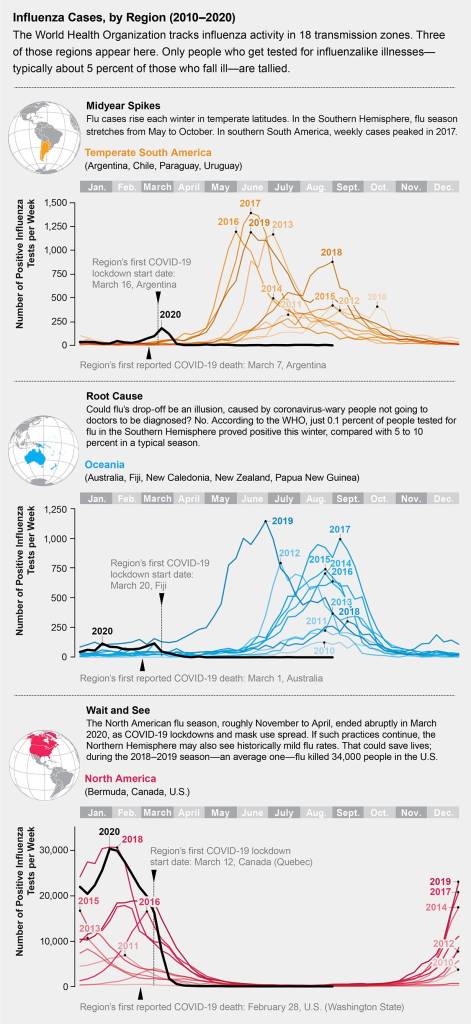- The preventive measures that can reduce your risk of catching the novel coronavirus can also protect against another infectious disease, influenza.
- Face masks and social distancing measures reduce COVID-19 spread, but they also work against other pathogens.
- New flu data for the Southern hemisphere shows that the annual flu epidemics were practically non-existent in 2020, as countries implemented measures to reduce coronavirus transmission.
President Trump confirmed he was infected with the novel coronavirus a few days ago, becoming the most prominent political figure in the world to have caught COVID-19. UK’s Prime Minister Boris Johnson and Brazilian President Jair Bolsonaro also came down with covid earlier this year. If it wasn’t clear after more than nine months of COVID-19, the virus spares no one. The coronavirus is so contagious that it will take advantage of any opening it can get. President Trump had an entire series of protocols in place to shield him from the virus, and it had been working well. Everyone who came in contact with him had to be tested beforehand, and that’s one reason why Trump rarely wore face masks. He even disparaged masks, and his most recent criticism came in the form of a comment targeting Joe Biden’s extensive use of masks during the debate on Tuesday. It’s likely that President Trump was already infected at the time he mocked Biden for wearing masks.
Aside from face mask use, health experts like Dr. Anthony Fauci advocate a few other measures that can reduce the risk of infection, including the frequent washing of hands, avoiding crowds of people, avoiding indoor locations like bars and restaurants, and practicing social distancing. Unsurprisingly, it turns out that social distancing and face masks protect against additional pathogens, not just SARS-CoV-2. And the list includes the various influenza viruses that are about to return with the cold weather.
One of the worst fears of healthcare workers and public health officials is the so-called “twindemic,” the imminent coronavirus-flu convergence. That’s a nightmare scenario that could overwhelm hospitals during winter in regions facing severe COVID-19 and flu epidemics. It’s also bad news for some unlucky patients who might have to fight a dual infection with both COVID-19 and the flu.
But it may not come to that if people continue observing public health measures. Scientists have published a new study showing that the influenza epidemic was practically non-existent in the Southern Hemisphere, where the seasons are reversed compared to the north. The flu epidemic was quickly flattened in March, just as COVID-19 was spreading with increased speed throughout the US, Europe, and other regions. “Never in my 40-year career have we ever seen rates … so low,” Mayo Clinic influenza expert Greg Poland told Scientific American.
More research is required on the subject, but several researchers agree that coronavirus prevention measures have directly impacted the flu. Poland said that other countries could see the most dramatic drops in flu cases in modern history if those measures continue.
US health experts still recommend that more people get flu shots this year, to further reduce the risk of getting infected with flu viruses. The flu vaccine could also prevent a dual coronavirus-flu infection down the road. The recommendation is worth following, especially in communities where there’s a tendency to avoid masks and ignore social distancing guidelines.
Only next summer will the world know whether the Northern Hemisphere can repeat the south’s success with the flu, although the coming months could bring the first relevant data. It’s likely that countries and US states with stronger face mask requirements due to COVID-19 will fare better against the flu as well.
Scientific American published an infographic that shows the evolution of the flu epidemics in South America, Oceania, and North America in the past 10 years. The data includes the 2020 flu season for South America and Oceania, showing the incredible drop in flu cases for the year to date. Both continents should have experienced peaks during their fall and winter seasons (May through September), but you can see what happened when people started distancing themselves from others and wearing face masks.









